What type of art was created during the Minimalist art movement?
Paintings, print art, design, ink and digital illustrations, sculptures and even lifestyle choices were a product of the Minimalist art movement.
Minimalism was created and popular during which years?
Minimalism flourished in the 1960s and 70s. Currently, it is seeing a revival that began around 2011 after the success of “The Minimalists” film on Netflix.
Where was Minimalist art made and popularised?
The Minimalist art movement began in the USA and spread across the globe.
Who are some famous Minimalism artists and artworks?
No. Green. No. I. by Yayoi Kusama
Red Yellow Blue 3 by Ellsworth Kelly
Drawings 1956-76 by Donald Judd
Interesting observations about the Minimalist art movement
Say as much as you can with as little as you need to say it. This is basically the philosophy of Minimalism. This is a stark contrast to the Maximalist art movement whose motto is “more is more.” You could say that the Minimalist motto is “less is more.” However, a Minimalist aims not just to keep it simple but also to pack the simple with enough meaning and purpose that more is just not needed.
The next time you see a minimalist painting of just a plain square, just look at the painting’s title. Or perhaps figure out the artist’s intention. If the square is enough to say or express what the artist wants to say, then no other ornamentation is needed. This, in a nutshell, is the essence of the Minimalist art movement.
Which art movement(s) came before the Minimalist movement?
The Maximalist art movement, Bauhaus and Constructivism came before the Minimalist art movement.
Which art movement(s) came after the Minimalist movement?
The Concept art movement came after the Minimalist art movement.
Top 10 Artworks of the Minimalist Art Movement
The Minimalist art movement, with its emphasis on simplicity, precision, and a reductionist approach to form, has produced iconic artworks. These pieces transcend traditional notions of artistic expression. In this exploration, we’ll discuss fascinating pieces of the Minimalist art movement.
No. Green. No. I. by Yayoi Kusama: The Infinite Quest for Solitude
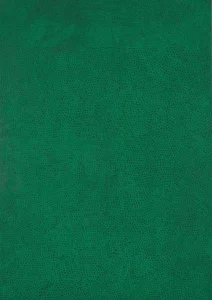
Yayoi Kusama, renowned for her avant-garde approach to art, unveiled “No. Green. No. I.” as a part of her Infinity Net series. Created in 1960, the painting is a testament to Kusama’s pursuit of solitude and introspection. Apparently, Kusama, in her studio, applied green paint dots across the canvas. She immersed herself in the rhythmic repetition of the act. Each dot, a symbol of infinity, reflects Kusama’s lifelong quest for inner peace and the boundless nature of the human psyche.
Red Yellow Blue 3 by Ellsworth Kelly: Chromatic Harmony in Three Hues
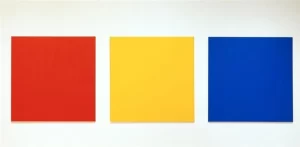
Ellsworth Kelly’s “Red Yellow Blue 3,” painted in 1963, stands as a vivid expression of chromatic harmony within the Minimalist movement. Kelly’s work has an interplay between the primary colours, rooted in his belief in the autonomy of form and colour. Kelly was fascinated by the simplicity of the three primary colours. He tried to make a visual symphony that transcends representation. “Red Yellow Blue 3” is a testament to Kelly’s commitment to the purity of colour. Viewers can revel in the simplicity of visual experience.
Drawings 1956-76 by Donald Judd: The Essence of Precision
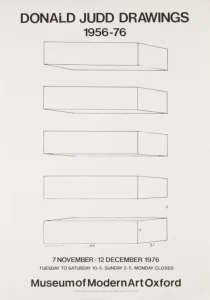
Donald Judd, a prominent figure in Minimalist sculpture, made significant contributions to the movement through his emphasis on precision and mathematical rigour. “Drawings 1956-76,” a collection of Judd’s works, reflects his dedication to clarity and form. Reports suggest that Judd, often described as a detailed draftsman, approached drawing with the same rigour as his three-dimensional works. Each line and form in his drawings is a deliberate expression of spatial relationships, capturing the essence of precision that defines Judd’s Minimalist philosophy.
144 Magnesium Square by Carl Andre 1969: A Walkable Landscape of Metal

Carl Andre’s “144 Magnesium Square,” created in 1969, is a groundbreaking work that challenges traditional notions of sculpture. Andre was inspired by the grid patterns of city sidewalks and created a walkable landscape of metal. The artwork comprises 144 identical metal squares arranged in a grid. This makes the artwork engaging with the materiality of the sculpture. This piece underscores Andre’s commitment to redefining the viewer’s relationship with art. It transforms the act of walking into a sensory exploration of form and material.
Monument series by Dan Flavin 1964: Illuminating the Space with Fluorescence
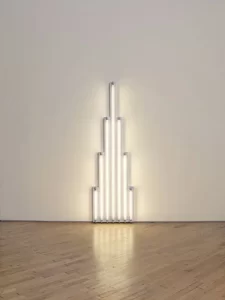
Dan Flavin’s “Monument” series, initiated in 1964, is an exploration of space and light through the medium of fluorescent tubes. Anecdotes from Flavin’s studio reveal his fascination with the ethereal quality of fluorescent light. The artist was inspired by the industrial aesthetics of common lighting fixtures. He used it to elevate these everyday objects to the realm of art. Installations in the “Monument” series is a testament to Flavin’s ability to transform space with the subtle interplay of luminosity. This helps viewers to experience the sublime beauty of minimalism.
Monochrome Painting by Yves Klein 1962: A Leap into the Void of Blue
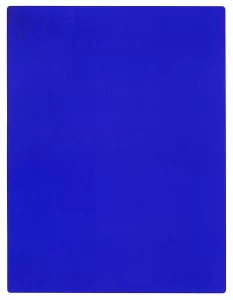
Yves Klein, a trailblazer in the realm of monochromatic art, presented his “Monochrome Painting” in 1962, featuring a radiant expanse of ultramarine blue. Klein was inspired by his deep connection to the colour blue and considered it a manifestation of the infinite. The artist’s unconventional approach involved immersing himself in the creation process, often using his own body as a brush. “Monochrome Painting” is an ode to Klein’s spiritual connection to colour. This makes the observer leap into the void of blue and experience the transcendent power of minimalism.
Die Fahne Hoch! By Frank Stella 1959: Unfurling the Flag of Innovation
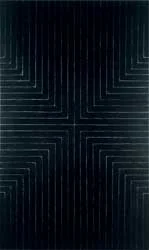
Frank Stella’s “Die Fahne Hoch!” (Raise the Flag!), crafted in 1959, is a pioneering work that challenged traditional notions of painting. Stella was driven by a desire to break free from the confines of the rectangular canvas and created a work that defied the conventional boundaries of artistic expression. The artwork’s irregular shape and stark black-and-white palette are symbolic of Stella’s commitment to innovation. “Die Fahne Hoch!” unfurls the flag of a new era in art, where form transcends tradition and paves the way for the avant-garde.
Two Open Modular Cubes/Half-Off by Sol LeWitt 1972: Modular Precision in Three Dimensions
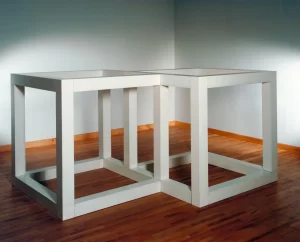
Sol LeWitt’s “Two Open Modular Cubes/Half-Off,” conceived in 1972, exemplifies his commitment to modular precision and conceptual art. Reports surrounding LeWitt’s working process show his approach to creating a system that generates form. LeWitt is known for his reliance on instructions rather than direct execution. He produced a set of rules that dictated the creation of the artwork. “Two Open Modular Cubes/Half-Off” is a manifestation of LeWitt’s conceptual genius. The artwork helps you explore the intersection of ideas and form within the realm of Minimalism.
Black Square by Kazimir Malevich 1915: The Groundbreaking Void of Suprematism

Kazimir Malevich’s “Black Square,” unveiled in 1915, marks a groundbreaking moment in the evolution of Suprematism and Minimalism. Apparently, Malevich’s creation of the iconic black square suggests a desire to move beyond representation and enter the realm of pure abstraction. The painting, often described as a void or an icon of nothingness, is symbolic of Malevich’s belief in the transformative power of geometric forms. “Black Square” is an enigmatic masterpiece that transcends the visual to become a symbol of artistic philosophy.
The Gathering Anguish Strikes Beneath by John Francis Murphy: Minimalist Landscape Poetry
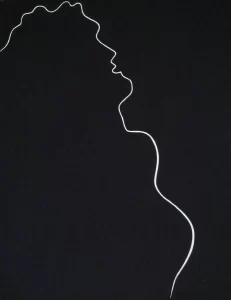
John Francis Murphy’s “The Gathering Anguish Strikes Beneath” introduces a touch of Minimalism to the realm of landscape painting. Created with a subdued palette and a meticulous reduction of detail, the artwork captures the essence of minimalist principles within the context of natural beauty. Murphy was inspired by the serenity of the landscape, which helped distil the emotional essence of nature into a minimalist composition. “The Gathering Anguish Strikes Beneath” is a poetic exploration of Minimalism within the traditionally expressive genre of landscape painting.
The Minimalist art movement provides glimpses into the minds of unique artists. They challenged conventions and redefined the boundaries of artistic expression. From Yayoi Kusama’s infinite dots to Ellsworth Kelly’s chromatic symphony each artwork tells a unique story of simplicity and precision. Also, it highlights the profound impact of Minimalism on the art world. These masterpieces continue to inspire and provoke contemplation. Even today, we can engage with the beauty of minimal forms and the rich narratives embedded within them.
*Images from Wiki Commons







0 Comments